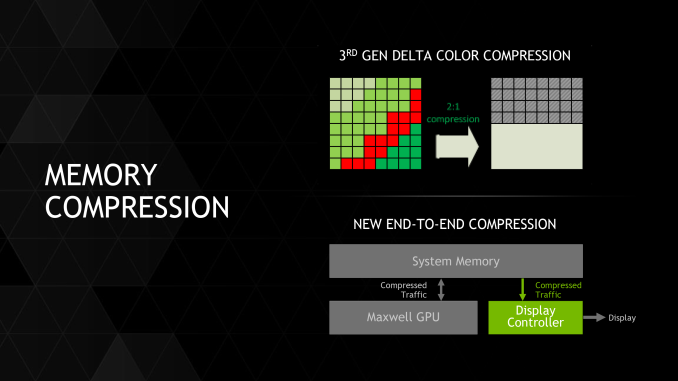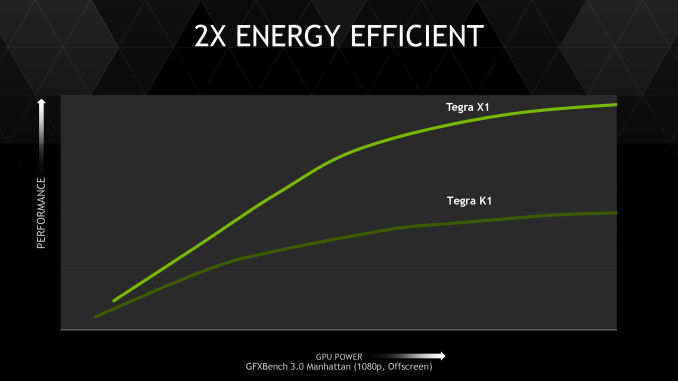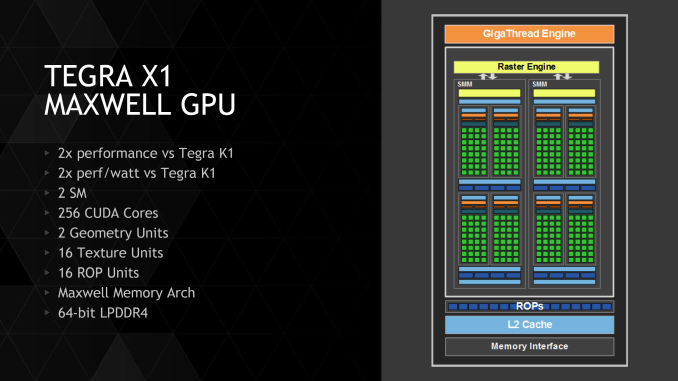NVIDIA Tegra X1 Preview & Architecture Analysis
by Joshua Ho & Ryan Smith on January 5, 2015 1:00 AM EST- Posted in
- SoCs
- Arm
- Project Denver
- Mobile
- 20nm
- GPUs
- Tablets
- NVIDIA
- Cortex A57
- Tegra X1
Tegra X1's GPU: Maxwell for Mobile
Going into today’s announcement of the Tegra X1, while NVIDIA’s choice of CPU had been something of a wildcard, the GPU was a known variable. As announced back at GTC 2014, Erista – which we now know as Tegra X1 – would be a future Tegra product with a Maxwell GPU.
Maxwell of course already launched on the PC desktop as a discrete GPU last year in the Maxwell 1 based GM107 and Maxwell 2 based GM204. However despite this otherwise typical GPU launch sequence, Maxwell marks a significant shift in GPU development for NVIDIA that is only now coming to completion with the launch of the X1. Starting with Maxwell, NVIDIA has embarked on a “mobile first” design strategy for their GPUs; unlike Tegra K1 and its Kepler GPU, Maxwell was designed for Tegra from the start rather than being ported after the fact.
By going mobile-first NVIDIA has been able to reap a few benefits. On the Tegra side in particular, mobile-first means that NVIDIA’s latest and greatest GPUs are appearing in SoCs earlier than ever before – the gap between Maxwell 1 and Tegra X1 is only roughly a year, versus nearly two years for Kepler in Tegra K1. But it also means that NVIDIA is integrating deep power optimizations into their GPU architectures at an earlier stage, which for their desktop GPUs has resulted chart-topping power efficiency, and these benefits are meant to cascade down to Tegra as well.
Tegra X1 then is the first SoC to be developed under this new strategy, and for NVIDIA this is a very big deal. From a feature standpoint NVIDIA gets to further build on their already impressive K1 feature set with some of Maxwell’s new features, and meanwhile from a power standpoint NVIDIA wants to build the best A57 SoC on the market. With everyone else implementing (roughly) the same CPU, the GPU stands to be a differentiator and this is where NVIDIA believes their GPU expertise translates into a significant advantage.
Diving into the X1’s GPU then, what we have is a Tegra-focused version of Maxwell 2. Compared to Kepler before it, Maxwell 2 introduced a slew of new features into the NVIDIA GPU architecture, including 3rd generation delta color compression, streamlined SMMs with greater efficiency per CUDA core, and graphics features such as conservative rasterization, volumetric tiled resources, and multi-frame anti-aliasing. All of these features are making their way into Tegra X1, and for brevity’s sake rather than rehashing all of this we’ll defer to our deep dive on the Maxwell 2 architecture from the launch of the GeForce GTX 980.
For X1 in particular, while every element helps, NVIDIA’s memory bandwidth and overall efficiency increases are going to be among the most important of these improvements since they address two of the biggest performance bottlenecks facing SoC-class GPUs. In the case of memory bandwidth optimizations, memory bandwidth has long been a bottleneck at higher performance levels and resolutions, and while it’s a solvable problem, the general solution is to build a wider (96-bit or 128-bit) memory bus, which is very effective but also drives up the cost and complexity of the SoC and the supporting hardware. In this case NVIDIA is sticking to a 64-bit memory bus, so memory compression is very important for NVIDIA to help drive X1. This coupled with a generous increase in memory bandwidth from the move to LPDDR4 helps to ensure that X1’s more powerful GPU won’t immediately get starved at the memory stage.
Meanwhile just about everything about SoC TDP that can be said has been said. TDP is a limiting factor in all modern mobile devices, which means deceased power consumption directly translates into increased performance, especially under sustained loads. Coupled with TSMC’s 20nm SoC process, Maxwell’s power optimizations will further improve NVIDIA’s SoC GPU performance.
Double Speed FP16
Last but certainly not least however, X1 will also be launching with a new mobile-centric GPU feature not found on desktop Maxwell. For X1 NVIDIA is implanting what they call “double speed FP16” support in their CUDA cores, which is to say that they are implementing support for higher performance FP16 operations in limited circumstances.
As with Kepler and Fermi before it, Maxwell only features dedicated FP32 and FP64 CUDA cores, and this is still the same for X1. However in recognition of how important FP16 performance is, NVIDIA is changing how they are handling FP16 operations for X1. On K1 FP16 operations were simply promoted to FP32 operations and run on the FP32 CUDA cores; but for X1, FP16 operations can in certain cases be packed together as a single Vec2 and issued over a single FP32 CUDA core.
There are several special cases here, but in a nutshell NVIDIA can pack together FP16 operations as long as they’re the same operation, e.g. both FP16s are undergoing addition, multiplication, etc. Fused multiply-add (FMA/MADD) is also a supported operation here, which is important for how frequently it is used and is necessary to extract the maximum throughput out of the CUDA cores.
In this respect NVIDIA is playing a bit of catch up to the competition, and overall it’s hard to escape the fact that this solution is a bit hack-ish, but credit where credit is due to NVIDIA for at least recognizing and responding to what their competition has been doing. Both ARM and Imagination have FP16 capabilities on their current generation parts (be it dedicated FP16 units or better ALU decomposition), and even AMD is going this route for GCN 1.2. So even if it only works for a few types of operations, this should help ensure NVIDIA doesn’t run past the competition on FP32 only to fall behind on FP16.
So why are FP16 operations so important? The short answer is for a few reasons. FP16 operations are heavily used in Android’s display compositor due to the simplistic (low-precision) nature of the work and the power savings, and FP16 operations are also used in mobile games at certain points. More critical to NVIDIA’s goals however, FP16 can also be leveraged for computer vision applications such as image recognition, which NVIDIA needs for their DRIVE PX platform (more on that later). In both of these cases FP16 does present its own limitations – 16-bits just isn’t very many bits to hold a floating point number – but there are enough cases where it’s still precise enough that it’s worth the time and effort to build in the ability to process it quickly.
Tegra X1 GPU By The Numbers
Now that we’ve covered the X1’s GPU from a feature perspective, let’s take a look the GPU from a functional unit/specification perspective.
Overall the X1’s GPU is composed of 2 Maxwell SMMs inside a single GPC, for a total of 256 CUDA cores. This compares very favorably to the single SMX in K1, as it means certain per-SMM/SMX resources such as the geometry and texture units have been doubled. Furthermore Maxwell’s more efficient CUDA cores means that X1 is capable of further extending its lead over Kepler, as we’ve already seen in the desktop space.
| NVIDIA Tegra GPU Specification Comparison | ||||
| K1 | X1 | |||
| CUDA Cores | 192 | 256 | ||
| Texture Units | 8 | 16 | ||
| ROPs | 4 | 16 | ||
| GPU Clock | ~950MHz | ~1000MHz | ||
| Memory Clock | 930MHz (LPDDR3) | 1600MHz (LPDDR4) | ||
| Memory Bus Width | 64-bit | 64-bit | ||
| FP16 Peak | 365 GFLOPS | 1024 GFLOPS | ||
| FP32 Peak | 365 GFLOPS | 512 GFLOPS | ||
| Architecture | Kepler | Maxwell | ||
| Manufacturing Process | TSMC 28nm | TSMC 20nm SoC | ||
Meanwhile outside of the CUDA cores NVIDIA has also made an interesting move in X1’s ROP configuration. At 16 ROPs the X1 has four times the ROPs of K1, and is consequently comparatively ROP heavy. This is as many ROPs as is on a GM107 GPU, for example. With that said, due to NVIDIA’s overall performance goals and their desire to drive 4K displays at 60Hz, there is a definite need to go ROP-heavy to make sure they can push the necessary amount of pixels. This also goes hand-in-hand with NVIDIA’s memory bandwidth improvements (efficiency and actual) which will make it much easier to feed those ROPs. This also puts the ROP:memory controller ratio at 16:1, the same ratio as on NVIDIA’s desktop Maxwell parts.
Finally, let’s talk about clockspeeds and expected performance. While NVIDIA is not officially publishing the GPU clockspeeds for the X1, based on their performance figures it’s easy to figure out. With NVIDIA’s quoted (and promoted) 1 TFLOPs FP16 performance figure for the X1, the clockspeed works out to a full 1GHz for the GPU (1GHz * 2 FP 16 * 2 FMA * 256 = 1 TFLOPs).
This is basically a desktop-class clockspeed, and it goes without saying that is a very aggressive GPU clockspeed for an SoC-class part. We’re going to have to see what design wins X1 lands and what the devices are like, but right now it’s reasonable to expect that mobile devices will only burst here for short periods of time at best. However NVIDIA’s fixed platform DRIVE devices are another story; those can conceivably be powered and cooled well enough that the X1’s GPU can hit and sustain these clockspeeds.















194 Comments
View All Comments
tipoo - Monday, January 5, 2015 - link
Oh I read that wrong, you meant the games, not the play store. Still, games almost never crash on this either.PC Perv - Monday, January 5, 2015 - link
Why do you guys write what essentially is a PR statements by NV as if they were independently validated facts by yourselves? I suppose you guys did not have time to test any of these claims.So you end up writing contradictory paragraphs one after another. In the first, you say NVIDIA "embarked on a mobile first design for the first time." That statement in and of itself is not something one can prove or disprove, but in the very next paragraph you write,
"By going mobile-first NVIDIA has been able to reap a few benefits.. their desktop GPUs has resulted chart-topping efficiency, and these benefits are meant to cascade down to Tegra as well." (??)
I suggest you read that paragraph again. Maybe you missed something, or worse the whole paragraph comes off unintelligible.
ABR - Monday, January 5, 2015 - link
Well the situation itself is confusing since NVIDIA might have designed Maxwell "mobile-first" but actually released it "desktop-first". Then came notebook chips and now we are finally seeing Tegra. So release-wise the power efficiency "cascades down", even though they presumably designed starting from the standpoint of doing well under smaller power envelopes.PC Perv - Monday, January 5, 2015 - link
But that is a tautology that is totally vacuous of meaning. One can say the opposite thing in the exact same way: "We went with desktop first, but released to mobile first, so that power efficiency we've learned "cascaded up" to the desktops.So the impression one gets from reading that explanation is that it does not matter whether it was mobile first or desktop first. It is a wordplay that is void of meaningful information. (but designed to sound like something, I guess)
Yojimbo - Monday, January 5, 2015 - link
Isn't that standard reviewing practice? "Company X says they did Y in their design, and it shows in Z." The reviewer doesn't have to plant a mole in the organization and verify if NVIDIA really did Y like they said. This is a review, not an interrogation. If the results don't show in Z, then the reviewer will question the effectiveness of Y or maybe whether Y was really done as claimed. Yes, the logical flow of the statement you quoted is a bit weak, but I think it just has to do with perhaps poor writing and not from being some sort of shill, like you imply. The fact is that result Z, power-efficiency, is there in this case and it has been demonstrated on previously-released desktop products.As far as your statement that one could say the opposite thing and have the same meaning, I don't see it. Because going "mobile-first" means to focus on power-efficiency in the design of the architecture. It has nothing to do with the order of release of products. That is what the author means by "mobile-first," in any case. To say that NVIDIA was going "desktop-first" would presumably mean that raw performance, and not power-efficiency, was the primary design focus, and so the proper corresponding statement would be: "We went desktop-first, but released to mobile first, and the performance is meant to "cascade up" (is that a phrase? probably should be scale up, unless you live on a planet where the waterfalls fall upwards) to the desktops." There are two important notes here. Firstly, one could not assume that desktop-first design should result in increased mobile performance just because mobile-first design results in increased desktop efficiency. Secondly and more importantly, you replaced "is meant to" with "so". "So" implies a causation, which directly introduces the logical problem you are complaining about. The article says "is meant to," which implies that NVIDIA had aforethought in the design of the chip, with this release in mind, even though the desktop parts launched first. That pretty much describes the situation as NVIDIA tells it (And I don't see why you are so seemingly eager to disbelieve it. The claimed result, power-efficiency, is there, as I previously said.), and though maybe written confusingly, doesn't seem to have major logical flaws: "1. NVIDIA designed mobile-first, i.e., for power-efficiency. 2. We've seen evidence of this power-efficiency on previously-released desktop products. 3. NVIDIA always meant for this power-efficiency to similarly manifest itself in mobile products." The "cascade down" bit is just a color term.
Yojimbo - Monday, January 5, 2015 - link
I just want to note that I don't think the logical flow of the originally-written statement is as weak as I conceded to in my first paragraph. In your paraphrase-quote you left out the main clause and instead included a subordinate clause and treated it as the main clause. The author is drawing a parallel and citing evidence at the same time as making a logical statement and does so in a way that is a little confusing, but I don't think it really has weak logical flow.chizow - Monday, January 5, 2015 - link
Anyone who is familiar with the convergence of Tegra and GeForce/Tesla roadmaps and design strategy understands what the author(s) meant to convey there.Originally, Nvidia's design was to build the biggest, fastest GPU they could with massive monolithic GPGPUs built primarily for intensive graphics and compute applications. This resulted in an untenable trend with increasingly bigger and hotter GPUs.
After the undeniably big, hot Fermi arch, Nvidia placed an emphasis on efficiency with Kepler, but on the mobile side of things, they were still focusing on merging and implementing their desktop GPU arch with their mobile, which they did beginning with Tegra K1. The major breakthrough for Nvidia here was bringing mobile GPU arch in-line with their established desktop line.
That has changed with Maxwell, where Nvidia has stated, they took a mobile-first design strategy for all of their GPU designs and modularized it to scale to higher performance levels, rather than vice-versa, and the results have been obvious on the desktop space. Since Maxwell is launching later in the mobile space, the authors are saying everyone expects the same benefits in terms of power saving from mobile Maxwell over mobile Kepler that we saw with desktop Maxwell parts over desktop Kepler parts (roughly 2x perf/w).
There's really no tautology if you took the time to understand the development and philosophy behind the convergence of the two roadmaps.
Mondozai - Monday, January 5, 2015 - link
No, it's not untelligible for reasons that other people have already explained. If you understand the difference between what it is developed for and what is released first you understand the difference. And apparently you don't.OBLAMA2009 - Monday, January 5, 2015 - link
man nvidia is such a jokeMasterTactician - Monday, January 5, 2015 - link
512 GFLOPS... 8800GTX in a phone, anyone? Impressive.